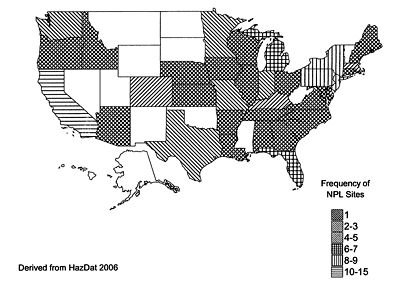
1,3-Dichloropropene
Encyclopedia
1,3-Dichloropropene, also known as Telone or simply 1,3-D, is a colorless liquid with a sweet smell. It exists as a mixture of the geometric isomers cis-1,3-dichloropropene and trans-1,3-dichloropropene. It dissolves in water and evaporates easily. It is used mainly in farming as a pesticide, specifically as a preplant fumigant and nematicide
. It widely used in the US and other countries, but in the process of being phased out in the European Union
.
A man who accidentally ingested DCP died with severe damage to his stomach and surrounding organs, but little else is known about the effects of ingesting these substances in humans. Animal studies have reported damage to the stomach lining, lung congestion, difficulty walking, and effects on the liver and kidneys from ingesting high levels of DCP.
A few workers who had skin contact with pesticides containing DCP developed blisters and an allergic reaction on their skin.
It is not known whether DCP can cause birth defects in humans. Pregnant rats that inhaled 1,3-dichloropropene gave birth to fewer pups or pups with lower body weight. This occurred at exposures high enough to be toxic to the mothers.http://www.atsdr.cdc.gov/tfacts40.html
DCP is testable via blood and urine tests, although it is only detectable in the body for 1-2 after exposure. Exposure level estimates are possible with a blood sample.
has extensive contamination information available.

Nematicide
A nematicide is a type of chemical pesticide used to kill parasitic nematodes.One common nematicide is obtained from neem cake, the residue obtained after cold-pressing the fruit and kernels of the neem tree. Known by several names in the world, the tree was first cultivated in India in ancient...
. It widely used in the US and other countries, but in the process of being phased out in the European Union
European Union
The European Union is an economic and political union of 27 independent member states which are located primarily in Europe. The EU traces its origins from the European Coal and Steel Community and the European Economic Community , formed by six countries in 1958...
.
Effects
1,3-Dichloropropene (DCP) causes irritation at the point of contact. Inhalation can cause nausea, vomiting, irritation of the skin, eyes, and throat; breathing difficulties, headache, and fatigue. These effects generally occur at exposure levels that are much higher than the background levels found in air or water. Rats and mice that inhaled DCP repeatedly for about 2 weeks had damage to the lining of the nose, and mice had damage to the lung.A man who accidentally ingested DCP died with severe damage to his stomach and surrounding organs, but little else is known about the effects of ingesting these substances in humans. Animal studies have reported damage to the stomach lining, lung congestion, difficulty walking, and effects on the liver and kidneys from ingesting high levels of DCP.
A few workers who had skin contact with pesticides containing DCP developed blisters and an allergic reaction on their skin.
It is not known whether DCP can cause birth defects in humans. Pregnant rats that inhaled 1,3-dichloropropene gave birth to fewer pups or pups with lower body weight. This occurred at exposures high enough to be toxic to the mothers.http://www.atsdr.cdc.gov/tfacts40.html
DCP is testable via blood and urine tests, although it is only detectable in the body for 1-2 after exposure. Exposure level estimates are possible with a blood sample.
Carcinogenicity
Evidence for the carcinogenicity of 1,3-dichloropropene in humans is inadequate, but results from several cancer bioassays provide adequate evidence of carcinogenicity in animals. The Department of Health and Human Services (DHHS) has determined that 1,3-dichloropropene may reasonably be anticipated to be a carcinogen. The International Agency for Research on Cancer (IARC) has determined that 1,3-dichloropropene is possibly carcinogenic to humans. The EPA has classified 1,3-dichloropropene as a probable human carcinogen.Use
1,3-Dichloropropene is used as a pesticide in the following crops: http://ca.water.usgs.gov/pnsp/crop/| Crop | Pounds (lb) | Primary Pesticide? |
|---|---|---|
| Tobacco | 12,114,887 | Yes |
| Potatoes | 12,044,736 | Yes |
| Sugar Beets | 5,799,613 | Yes |
| Cotton | 3,735,543 | Yes |
| Peanuts | 3,463,003 | Yes |
| Sweet Potatoes | 1,210,872 | Yes |
| Onions | 674,183 | Yes |
| Carrots | 531,752 | Yes |
| Watermelons | 133,801 | No |
| Cantaloups | 121,395 | No |
| Cucumbers | 76,735 | No |
| Strawberries | 71,753 | No |
| Sweet Peppers | 28,247 | No |
| Melons | 12,471 | No |
| Blueberries | 3,090 | No |
| Asparagus | 1,105 | No |
Contamination
The ATSDRAgency for Toxic Substances and Disease Registry
The Agency for Toxic Substances and Disease Registry is a federal public health agency within the United States Department of Health and Human Services. The agency focuses on minimizing human health risks associated with exposure to hazardous substances...
has extensive contamination information available.


